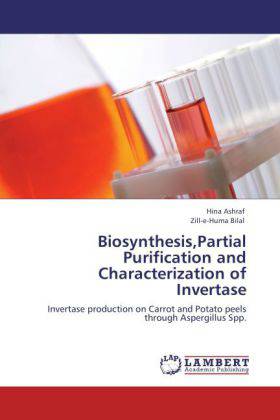
- Afhalen na 1 uur in een winkel met voorraad
- Gratis thuislevering in België vanaf € 30
- Ruim aanbod met 7 miljoen producten
- Afhalen na 1 uur in een winkel met voorraad
- Gratis thuislevering in België vanaf € 30
- Ruim aanbod met 7 miljoen producten
Zoeken
Biosynthesis, Partial Purification and Characterization of Invertase
Invertase production on Carrot and Potato peels through Aspergillus Spp.
Hina Ashraf, Zill-E-Huma Bilal
Paperback | Engels
€ 58,45
+ 116 punten
Omschrijving
Invertase (β-D (fructofuranosidase, EC 3.2.1.26) is one of the important commercial enzymes used in food industry. It catalyses the reaction of detachment of the terminal non-reducing β-D-fructofuranoside residue in β-D-fructofuranosides. A wide range of microorganisms produce Invertase and can, thus, utilize sucrose as the only carbon source and as inducer of such enzyme. Food processing industry produces an enormous amount of carbohydrate wastes, which pose increasing disposal costs and environmental challenges. Beside their pollution and hazardous aspects, these organic wastes are rich in biodegradable materials, and have potential to be used as suitable substrates for biotechnological productions. The present study was planned to produce Invertase from indigenous wastes including carrot and potato peels, as substrates for Aspergillus species through solid state fermentation (SSF). For this purpose, five different species were screened. Higher activities of Invertase were produced by Aspergillus niger on carrot peels and A.terreus on potato peels. Hence this study may helpful to produce, purify and characterize the enzyme by using the food processing wastes.
Specificaties
Betrokkenen
- Auteur(s):
- Uitgeverij:
Inhoud
- Aantal bladzijden:
- 124
- Taal:
- Engels
Eigenschappen
- Productcode (EAN):
- 9783848407361
- Verschijningsdatum:
- 5/03/2012
- Uitvoering:
- Paperback
- Formaat:
- Trade paperback (VS)
- Afmetingen:
- 152 mm x 229 mm
- Gewicht:
- 190 g

Alleen bij Standaard Boekhandel
+ 116 punten op je klantenkaart van Standaard Boekhandel
Beoordelingen
We publiceren alleen reviews die voldoen aan de voorwaarden voor reviews. Bekijk onze voorwaarden voor reviews.











